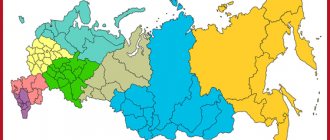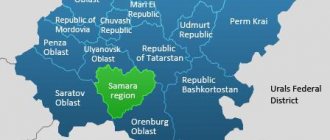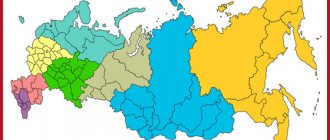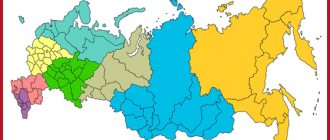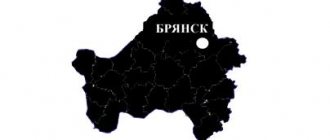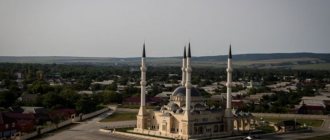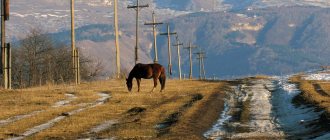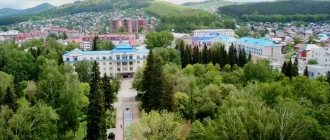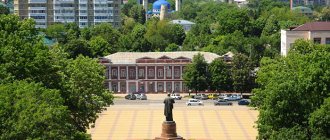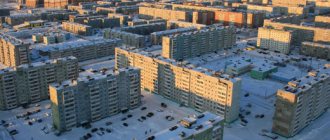| Unfinished article about the Russian region This article about the Russian region is in the process of being written. It requires significant revision and/or may have major flaws in design and content. You can help the project and finish it. |
Flag of the Chechen Republic Coat of arms of the Chechen Republic
Chechen Republic
(
Nokhchiin Respublika
) is a republic within Russia, located in the North Caucasus. Territory - 15,647 km², population - 1,478,726 people (2020). The capital is the city of Grozny. The head of the Chechen Republic is Ramzan Akhmatovich Kadyrov.
- Argun Gorge
- Lake Kezenoy-Am
- Döre Fortress
- Grozny City
Chechen Republic: briefly about the main thing
When the Second Chechen War began, the administration of the Chechen Republic was formed. Its leader was Akhmat Kadyrov, who went over to the side of Russia. In 2003, the Chechen Republic adopted a new Constitution, according to which it became part of the Russian Federation. Also, in 2003, presidential elections were held in which Akhmat Kadyrov was elected. However, he was killed on May 9, 2004 in Grozny due to a terrorist attack.
Alu Alkhanov took the place of Akhmat Kadyrov in 2004. He resigned after 3 years, in 2007. Ramzan Kadyrov, the son of Akhmat Kadyrov, became the new president of the Chechen Republic in 2007.
According to the State Committee of Russia, the population of Chechnya is 1,324,767 people. (2013). The most populated is the capital - the city of Grozny (250,803 people), the second place is occupied by the city of Urus-Martan (52,399 people).
Representatives of various nationalities live in the Chechen Republic: Chechens, Russians, Kumyks, Chamalals, Nogais, Ingush, Tatars and many others. etc. The official languages of the republic are Chechen and Russian.
The republic contains a large number of beautiful places: rivers, lakes, waterfalls, high mountains, etc.
Content
- 1 Cities of the Chechen Republic
- 2 Economy of the region 2.1 Major projects
- 2.2 News about the development of the region
- 2.3 Enterprises of the region 2.3.1 Enterprises of the mechanical engineering industry
- 2.3.2 Enterprises of the fuel and energy complex
- 2.3.3 Enterprises of the chemical complex
- 2.3.4 Enterprises of the metallurgical complex
- 2.3.5 Light and textile industry enterprises 2.3.5.1 Garment industry
- 5.1 Population of Chechnya
- 7.1 Photo reviews of the region
Interesting facts about Chechnya
- The main religion is Islam;
- State languages: Chechen and Russian;
- Now the republic is home to just under one and a half million people;
- The bulk of the republic's population are Chechens;
- In Chechnya, penny coins do not circulate and prices in local retail outlets are always multiples of one ruble;
- In Chechnya, cars are almost never stolen (but times are changing);
- Contrary to popular belief, no one forces Chechen women to wear headscarves;
- Almost all surnames in Chechnya are based on the name of an ancestor;
- This republic was the first territory where a ban on the operation of slot machines was adopted;
- According to local traditions, men are considered adults from the age of 15. That is, at this age they must themselves be responsible for all the actions they have committed;
- Chechens, like the Ingush, call themselves Vainakhs. Translated into Russian, the word “vai” means “one’s own”, and “nakh” means “people”. Thus, Vainakh means “one’s people” or “one’s people.”
Population
The population of Chechnya is around one and a half million people. Almost three hundred thousand people live in the largest city of Grozny. The population density today is more than 90 people. per 1 sq. km.
The age distribution of residents is as follows: more than half of the population is of working age, approximately 35% are children, and only 8% are elderly.
In terms of national composition, at the beginning of the nineties, Chechnya is a multinational republic, dominated by Chechens and Russians. But over the past twenty-five years, Chechens have become predominant in the national composition. During many conflicts, the region's large Russian and Russian-speaking population had to flee to other regions. Many died in ethnic cleansing carried out by militants.
Photos of Chechnya
The authors of the photographs are Timur Agirov and Abdullah Bersaev (personal pages on livejournal.com and the Open Caucasus project).
History of the Chechen Republic
People have lived in the plains of Sunzha and Terek since time immemorial, but in the 13th century the ancestors of modern Chechens were forced to leave for the mountainous areas. The reason for this was the turmoil brought during the Tatar-Mongol invasion.
Thus, until the 16th century, the bulk of Chechens lived in mountainous areas. Around the same period, in the society of representatives of the Vainakh ethnic group, the teip, or as it is also called, the tribal structure of society, began to emerge, in which the territory of a person’s residence and his family ties, which are very strong among this people to this day, were of great importance.
Since the 16th century, Chechens began to gradually move to the flatlands again. And at the same period, one Shikh-Murza Okotsky begins to establish connections with Moscow and sends his like-minded people to the capital of Russia, called upon to discuss the entry of Chechnya into Russia.
Around the same time, the first Cossack settlers appeared here, marking the beginning of the formation of the so-called Terek Cossacks. In the 18th century it ceased to be free, and the Cossacks officially became part of the Russian armed forces. The main task of the Terek Cossacks was to protect the southern borders of Russia.
In the 18th century, Russian military campaigns into the territory of Chechnya became regular. The cause of the conflict was the constant complaints of the Cossacks about the raids of the indigenous population on their settlements, which did not contribute to the security of the borders.
In the 19th century, Emperor Alexander II issued a decree according to which Chechnya officially became part of the Russian Empire, along with other districts. This territory began to be called the Terek region.
After the Russian civil war of 1917, an Islamic state was created on the territory of the republic. The head of the North Caucasus Emirate was Uzun Haji (emir). However, the emirate soon lost its independence and became known as the Mountain Autonomous Soviet Socialist Republic, as it became part of the Russian Soviet Federative Socialist Republic (RSFSR).
Then, with the advent of Soviet power, at the beginning of the 20th century, the Terek region was divided into Ingush and Chechen districts. Then, in 1934 and 1936, it was alternately renamed the Chechen-Ingush Autonomous Okrug and the Chechen-Ingush Autonomous Soviet Socialist Republic.
During the Great Patriotic War, at the end of winter 1944, the entire population of Chechnya was deported to Kazakhstan and Central Asia. The reason for these repressive measures was the unfair accusation of the Chechens and Ingush that they allegedly acted as accomplices of the fascist troops.
As a result, the Chechen-Ingush Autonomous Soviet Socialist Republic was disbanded. Its territories were partially annexed to other geographical entities, and partially included the Grozny region. Thus, the city of Grozny was preserved and became the administrative center of the newly formed region. In 1957, a decision was made to restore justice to the Chechen-Ingush Autonomous Soviet Socialist Republic, and the indigenous population returned to their native lands. However, the problem of the land issue still exists between some regions.
Climatic features
The climate of Chechnya these days is directly dependent on the mountainous terrain and warm temperatures. The republic, which is relatively small in territory, is distinguished by a significant number of natural areas: from north to south, the terrain changes from deserted semi-desert to steppe, forest-steppes with plant diversity already appear near the mountains; a little to the south there is a zone of mountain forests, which gradually develops into a mountain-meadow territory, and above there are high-altitude mountain ranges lying above the beginning of the strip of permanent snow. The mountain peaks here are occupied by large glaciers and eternal snow. A clear vertical mountain zonation, manifested in the form of changes in mountain landscapes on the slopes from the base to the peaks, is a common feature for such mountain areas.
However, as we have already said, Chechnya is not only mountains. The local semi-desert covers the relatively small Terek-Kuma lowland. The climate, as expected for such places, is quite dry, the summer season is characterized by high temperatures, and dry winds are common. But the winter is short, with little snow, lasting no more than four months.
A significant area of the lowland part of Chechnya adjoins the forest-steppe zone. There is not much precipitation here - approximately 500-600 mm per year.
In the mountains, part of the territory is occupied by wooded and meadow areas, which allow for nomadic cattle breeding. At the very tops of the mountains of the Side Range there is a zone of eternal snow and glaciation; the weather here is frosty, and strong winds and snow often blow through. Precipitation is mainly in the form of snow.
War in Chechnya
During the collapse of the USSR, various national movements intensified in Chechnya. The Executive Committee of the national congress was created here, thus, two branches of government worked simultaneously in the republic. The national movement was led by Dzhokhar Dudayev. The major general set his goal to achieve Chechnya's secession from the Soviet Union. The official head of the republic, Doku Zavgaev, did not give in to his position, and as a result, this contradiction formed the basis of a long-term military conflict.
After perestroika in 1991, Boris Yeltsin signed a decree introducing a special situation in the Chechen-Ingush Autonomous Soviet Socialist Republic. In response to this, Dzhokhar Dudayev began creating self-defense units. The first armed conflict between Russian and Chechen troops occurred in November 1991, when Dudayev’s fighters blocked planes with Russian military on board at Khankala airport. As a result of negotiations, Russian military personnel were withdrawn from Chechnya, leaving there most of the military equipment and weapons, which subsequently passed to Dudayev’s fighters.
The Chechen-Ingush Autonomous Soviet Socialist Republic ceased to exist and was divided into Chechnya and Ingushetia. In the last autumn of 1992, military operations took place on the territory and the displacement of the Ingush from the suburban area, and in the summer of 1992 it officially became part of the RSFSR as the Ingush Republic. In the same year, the Council of Russian Deputies recognized the existence of the Chechen Republic and introduced corresponding amendments to the constitution.
Ichkeria
Despite the fact that the independence of Chechnya was not recognized by any state, the republic actually existed independently, having its own government, courts, flag, coat of arms, anthem, etc. In 1993, it received a new name and became known as the Chechen Republic of Ichkeria.
The situation in Chechnya at that time was extremely tense. Business in the republic was mainly criminal, and was often based on hostage-taking, oil theft or drug trafficking.
The rampant crime became the reason that opposition movements began to form in Chechnya that did not support the Dudayev regime. Thus, the Provisional Council of the Chechen Republic arose here, whose members fought to overthrow Dudayev and enlisted the support of Russia.
This was followed by two large military campaigns. The first Chechen war, which began with the storming of Grozny, lasted from 1994 to 1995. Dzhokhar Dudayev died in 1995 from an air missile strike.
The second Chechen war began in 1999. Active hostilities in Chechnya ended in the early spring of 2000. Further, the military conflict was of a partisan nature. Now the Chechen Republic is officially part of the Russian Federation.
Religion
What is the official religion in Chechnya? Chechnya is historically a Muslim region. The main religion is Sunni Islam. Here he received a form of Sufism, spreading through various religious organizations that consist of Muslim groups - vird brotherhoods. The total number of such organizations today exceeds three dozen. Those who believe in Sufism in the Chechen Republic are Sunnis, relying on the main tenets of Islam, but at the same time guided by Sufi customs, believing in their ustaz.
The history and culture of Chechnya are largely based on Islam. Oral Muslim prayers, holy rites, ritual trips to holy places, religious rituals, and so on play a large role in the traditional faith.
Since the beginning of 1992, a new religious movement for the region (Wahhabism) began to spread in Chechnya, acting as a religious and political counterweight to local Islam. The Wahhabis carried out openly expressed ideological activities, which were aimed against Russian society and the state.
Now the activity of Muslim extremists, as well as religious terrorists, is not allowed. There is a rapid development of traditional Islam, which is visible not only in the creation of mosques and Muslim schools, but also in the religious education of modern youth and even in the appearance of the Chechen flag. Traditionalists, in their regular calls and prayers to Muslims, call for common union, spiritual growth, and oppose drug addiction and other bad deeds.
Authorities of Chechnya
The head of the Chechen Republic is Ramzan Kadyrov. He has held this position since 2007, after the official voluntary resignation of Alu Alkhanov.
And the first president of the Chechen Republic was Akhmad Kadyrov, the father of Ramzan Kadyrov. Under him, a constitution was adopted in 2003, according to which the republic became part of the Russian Federation. Akhmat Kadyrov died in 2004. He became one of the victims of the terrorist attack in Grozny.
Parliament of Chechnya:
- Council of the Republic - 21 people, according to the number of districts of the republic;
- The People's Assembly - 40 deputies - 20 from party lists and 20 from single-mandate constituencies.
On April 11, 2007, Odes Baysultanov was appointed Chairman of the Government of the Chechen Republic.
Geography of the Chechen Republic
Geographically, Chechnya is located in the North Caucasus in the area of the Sunzha and Terek rivers. To the north of the republic steppe and semi-desert terrain predominates, to the south there are mountain ranges (Caucasus Mountains), and in the middle there is forest-steppe. The local climate can be classified as continental.
In addition to the Terek and Sunzha, on the territory of the republic there are 17 more rivers, 15 lakes, and five waterfalls. There are also many mountain ranges here, five of them are over four thousand meters.
Conventionally, the republic can be divided into several main zones:
- Predgorny. This land, partially covered with forest, has been famous for its fertility from time immemorial. Thanks to the fairly mild climate, fruit-bearing southern plants and trees have long taken root here. The value of this site was also given by the fact that many trees grow here, which are used to build houses and other structures;
- Mountain. People call this area the “black mountains”. Here there are mostly mountain ranges, “decorated” with beautiful waterfalls and gullies. It is noteworthy that a large area of rocks here is covered with black soil, thanks to which not only many ordinary trees grow in the forests, but also fruit-bearing species: plum, pear, dogwood, apple tree, etc. The huge number of herbs growing in the local forests, among which there are many medicinal ones, is also striking;
- Alpine. Here the picture is different. The harsh climate and cold caused the appearance of eternal snow and glaciers on the tops of the ridges. In the northern part of Chechnya, where the mountains are slightly lower, you can see valleys covered with black earth soil. During the warm season, they are usually used as pasture;
- Plain. There are two main plains in the Chechen Republic, one is located on the left bank of the Terek, and the second is between the Black Mountains, Termsky, Grozny, and Sunzhensky mountain ranges.
The republic can be proud not only of its incredibly beautiful mountain landscapes and generous fertile soil, but also of the presence of various natural resources on its territory. Chechnya has three dozen gas and oil fields. Gypsum, mineral paints, sandstone, limestone, etc. are also mined here. Famous healing mineral springs are also located here.
Notes
- Trends in the development of the industrial sector of the economy of the Chechen Republic - Economic sciences - Fundamental research
- Industry – Investment portal of the Chechen Republic
- Kadyrov: Chechnya's economy is recognized as the most effective among Russian regions
- Chechen phenomenon
- Population and labor resources
- Caucasian Knot | Russian Population Census 2010: Chechen Republic
- The population of the Chechen Republic is growing
| [ + ] Regions of Russia | |
| Regions of the North-West (NWFD) | St. Petersburg • Leningrad region • Arkhangelsk region • Vologda region • Kaliningrad region • Karelia • Komi • Murmansk region • Nenets Autonomous Okrug • Pskov region |
| Regions of the Volga region (VFD) | Bashkortostan • Volgograd region • Kalmykia • Kirov region • Mari El • Mordovia • Nizhny Novgorod region • Orenburg region • Penza region • Perm region • Samara region • Saratov region • Tatarstan • Udmurtia • Ulyanovsk region • Chuvashia |
| Regions of Southern Russia (SFD) | Sevastopol • Republic of Crimea • Adygea • Astrakhan region • Krasnodar region • Rostov region |
| Regions of the North Caucasus (NCFD) | Dagestan • Ingushetia • Kabardino-Balkaria • Karachay-Cherkessia • North Ossetia • Stavropol Territory • Chechen Republic |
| Regions of the Urals (Ural Federal District) | Kurgan region • Sverdlovsk region • Tyumen region • Khanty-Mansi Autonomous Okrug - Yugra • Chelyabinsk region • Yamalo-Nenets Autonomous Okrug |
| Regions of Siberia (Siberian Federal District) | Altai Republic • Altai Territory • Irkutsk Region • Kemerovo Region • Krasnoyarsk Region • Novgorod Region • Novosibirsk Region • Omsk Region • Tomsk Region • Tyva • Khakassia |
| Regions of the Far East (FEFD) | Amur Region • Buryatia • Jewish Autonomous Region • Trans-Baikal Territory • Kamchatka Territory • Magadan Region • Primorsky Territory • Yakutia • Sakhalin Region • Khabarovsk Territory • Chukotka Autonomous Okrug |
| see also | Regions of Russia • Federal districts of Russia • Abolished subjects • Economic regions of Russia • Cities of Russia |
Rivers
The rivers on the territory of Chechnya are scattered. There are 20 main rivers in total, these are: Terek, Argun, Gekhi, Sunzha, Sharoargun, Aksai, Baas, Khulkhulau, Martan, Yamansu, Shalazha, Gums, Yaryk-su, Roshnya, Fortanga, Michik, Netkhoi, Shalazha, Chemulga, Assa.
There are 14 lakes, the largest and deepest of them is Lake Kezenoyam, located in the North Caucasus and is mountainous (belongs to the Vedeno region).
- Lakes of the Achkhoy-Martan region: Galayn-Am, Gekhi-Am.
- Lakes of the Shelkovsky region: Bolshoye, Solenoye, Cherkasskoye.
- Lakes of the Shatoi region: Urgyukhoy-am, Bezik-Ome.
- Lakes of the Naursky district: Kapustino, Mayorskoye, Generalskoye and Chechenskoye. One lake belongs to the Sharoysky district - Amga, as well as to Itum-Kalinsky - Chentiy-am.
There are only five waterfalls, these are: Argun, Genikh, Sharo-Argun, Khulkhuloi and Aksai waterfalls.
The highest peaks of the mountains were called “Four-thousander peaks”, befitting their height: Maistismta (4082 m), Donosmta (4174 m), Komito (4262 m), Diklosmta (4285 m), Tebulosmta (4493 m).
Natural attractions
Bragunsky ridge
Coordinates: 43.4116667, 45.9236111 How to get there: from Grozny north towards the village of Vinogradnoye
Stretching for 24 kilometers along the Terek River, the ridge is famous for its geothermal springs, which are part of a specially protected natural area of republican significance. The water temperature reaches +98 degrees. According to travelers, the springs have healing properties.
The springs formed by the tectonic rupture are used to treat a number of diseases of the gastrointestinal tract, kidneys and liver.
Mount Karakh
Coordinates: 43.4286111, 45.9113889 How to get there: from Grozny to the north towards the village of Vinogradnoye
One of the peaks of the Bragunsky ridge, rising 336 meters above sea level. The easiest and easiest peak to climb from the list of mountain ranges in Chechnya. But it is worth noting that the landscapes, air and climate, unlike the southern ranges, are completely different here.
Assa River
Coordinates: 43.1517, 45.2455 How to get there: from Grozny to Zakan-Yurt
The river, originating from the northern slopes of the Caucasus Range in Georgia, flows through the territory of Chechnya and Ingushetia. The rapid and stormy Assa forms a picturesque gorge.
Local residents tell a beautiful legend about the river, how Assa protected a shepherd from robbers - scaring away with her flow, she forced the offenders to stay on the other bank.
Lake Kezenoy-Am
Coordinates: 42.4638, 46.0911 How to get there: from Grozny towards Argun, then along the mountains through Shali, Serzhen-Yurt, Vedeno to the Kharami pass
The largest lake in the North Caucasus is located on the border of Chechnya and Dagestan at an altitude of 1870 meters above sea level. Research by geologists has shown that the deep and crystal clear lake appeared as a result of an earthquake. A rock collapse occurred and blocked the flow of two rivers at once - Khorsum and Kauhi.
The cataclysm formed a hundred-meter natural dam and, connecting the rivers, created a picturesque and deep lake.
In 2015, a sports and tourist complex opened its doors on the shore, where tourists began to actively flock.
The path to the lake is not easy and quite long, so it is best to hire an experienced guide.
Mount Ashenethe
Coordinates: 42.9292, 46.3017 How to get there: from Grozny towards Argun, then along the mountains through Shali and Vedeno
A mountain whose peak is not difficult to conquer. From an altitude of 1250 meters above sea level, views of mountain ranges open up. The easy route and close distance to the capital of Chechnya made the place touristic and frequently visited.
According to one legend, mountain Christians called Lam-Krists once lived on the top of Ashenete.
Lake Bezinom
Coordinates: 42.4348, 45.5510 How to get there: from Grozny to the south, through Starye Atagi to the village of Dai
Conveniently located at the foot of the mountains, Lake Bezinom is located 10 kilometers from the village of Dai in the Vedeno region in the south of Chechnya. The area of the pool is two hectares.
The lake was formed due to the raging elements - a landslide blocked the valley of a small river. Initially, the depth reached 50 meters, but over time the reservoir became shallow without losing its value - it is a specially protected natural area of republican significance.
Mount Kirilam
Coordinates: 42.4138, 45.5115 How to get there: from Grozny to the south through the village of Khimoi
A small but very picturesque peak is located in the south of the republic, a hundred kilometers from the capital. The maximum height is 2800 meters above sea level, and the terrain of the area allows tourists to climb without special training.
Mount Tebulosmta
Coordinates: 42.3424, 45.1843 How to get there: Russian border with Georgia
The highest mountain peak in Chechnya is located at an altitude of 4492 meters above sea level on the border of the republic with Georgia. The area is covered with eternal snow and is famous for rock crystal druses, the size of which sometimes reaches one meter.
This amazing natural landmark was first conquered in September 2021. The pioneers were trained professionals - instructors from the Russian University of Special Forces. It took 17 hours to climb the steep western slope. In the near future, it is planned to create a special camp for mountain training and mountaineering at one of the passes on the way to Tebulosmta.
Mount Dyclosmith
Coordinates: 42.2932, 45.4651 How to get there: Russian border with Georgia and Dagestan
The mountain did not immediately acquire its modern name. In pre-revolutionary years, the massif was called Dzana-Kort, which translated from Chechen means “mountain asking for rain.”
The peak is the natural border of Chechnya, Dagestan and Georgia. The ascent to an altitude of 4285 meters above sea level lies through the passes of East and West Diklo, West Diklosmt.
Mount Comito
Coordinates: 42.3158, 45.3559 How to get there: Russian border with Georgia
Located on the border with Georgia, the mountain peak rises 4261 meters above sea level. Komito is considered one of the highest points in Chechnya and Russia.
Despite the height and difficulty of the climb, it has acquired the unofficial status of a popular tourist route. The path to the top stretches along a narrow path along small mountain rivers and streams, eternal snow and glaciers.
Mount Donosmta
Coordinates: 42.3016, 45.4113 How to get there: Russian border with Georgia
Donosmta is part of the Main Caucasus Range complex, forming a natural border between Chechnya, Georgia and Dagestan.
For the first time, one of the highest mountain peaks in our country was conquered back in 1889, when mountaineering became popular in the Russian Empire.
The peak, 4176 meters above sea level, belongs to the third category of difficulty, so only trained and experienced climbers dare to take on the long and difficult climb.
If you have not yet chosen where you will live and want to save money when booking, we recommend using the RoomGuru service. Firstly, it contains hotels, apartments and guest houses from many different booking systems, so you won’t miss out on a worthwhile option. Secondly, you can immediately compare prices for one place in different services and book where it is cheaper (this is not always Booking!).
Fauna of Chechnya
Due to the fact that there are several different climatic areas on the territory of the republic, its flora and fauna are striking in their diversity. The climate here, depending on the area, can be continental, arid or alpine. In one area, the average winter temperature can be only “-3” degrees, and in another from “-12” to “-15” degrees. Precipitation in the republic is also uneven.
Considering that on the territory of Chechnya there are different natural zones, ranging from steppes and deserts, to forests, forest-steppes and glaciers in the mountains, you can meet a wide variety of fauna here.
In total, more than 400 species of animals live on the territory of the republic. Of these, about 200 are “Red Book”, which is why the republican authorities pay great attention to the fight against poachers exterminating rare species of animals.
Bears, lynxes and forest cats live in the mountains and gorges. The local forests are home to foxes, roe deer, chamois, weasels, badgers, Caucasian red deer and saiga.
The last animal, in appearance, very much resembles a ram with long legs, and prefers to live on dry, flat steppes. But in the mountains it is almost impossible to find this Caucasian animal. Also, here you can often see a wild jackal, which is a cross between a fox and a wolf. The jackal is omnivorous, and in the absence of meat or fish, is ready to eat, for example, fruits or wild berries.
The flora of the republic is also very rich. And if camel thorn and wormwood mainly grow on arid soils, then the black earth lands delight us with high yields of wheat, corn and various garden crops. And in the mountain meadows many medicinal herbs grow, and here local residents often set up apiaries to collect surprisingly aromatic, tasty and pure honey.
Geographical position
The geographical location of Chechnya is determined primarily by its mountainous terrain. The region contains several separate mountainous structures. This is a significant part of the Terek-Sunzha mountainous area, which consists of two ancient folds of small ridges lying in a latitudinal current. The eastern section of the Tersky ridge is made up of another ridge - the Bragunsky, to the east lies the Gudermes ridge. The eastern territory of the Sunzhensky ridge is occupied by the peculiar Grozny ridge. All mountain structures do not have sharp outlines.
The southern part of the region, called mountainous Chechnya, is located in the Greater Caucasus. All four leading ridges pass here (except for a large number of local mountain linear formations), which are located parallel to the north of the mountainous expanses of the Greater Caucasus Range. The highest mountain in the Eastern Caucasus is located here. Mountain lines are often cut by large gorges with mountain river flows.
But Chechnya is not only mountains. There are several plains and low-lying areas on the territory of the republic. Particularly notable in this regard is the Chechen Plain with good soils - the area with the highest population density in the region. In the flat part of Chechnya, the lands are mostly improved; in the valleys there are many relatively small rivers. In the valleys of these rivers lie small areas of wooded areas.
So when asked where Chechnya is located, we can say that it is the Caucasus, mountains and somewhat flat terrain.
Coat of arms of Chechnya
Emblem of the Chechen Republic
The State Emblem of Chechnya was approved on June 22, 2004. The coat of arms is made in a round shape of a two-dimensional plane. It has four colors: yellow, white, red and blue.
In the central part of the Coat of Arms is the Symbol of Unity and Eternity in the form of a national Chechen ornament, which is painted red. The mountains, the oil rig and the historical Vainakh tower are painted blue.
On a blue background, yellow ears of wheat are depicted, framing the inner circle. They symbolize the wealth of the people of Chechnya.
The outer circle has an image of a red pattern of ornaments in the national style of the Chechens on a yellow background.
Links
- Government portal of the Chechen Republic
- "Multifunctional center for the provision of state and municipal services (MFC) of the Chechen Republic"
- Chechen Republic
- Made in the Republic of Chechnya
- Article in Cyclopedia
- Myths and reality - article by the Caucasus Center for Strategic Studies on the report “Threat to National Security” by oppositionist Ilya Yashin
Photo reviews of the region
- Around the Caspian Sea. Caucasus Sergey Dolya 2014
- Chechnya Sergey Dolya 2014
- Mosque “Heart of Chechnya”, Grozny. North Caucasus, part 15 Сhistoprudov 2014
